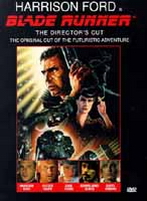
Arch
443/646: Architecture and Film
Fall 2006
Blade Runner
 |
Arch
443/646: Architecture and Film Blade Runner |
|
Discussion Questions:
Please answer the questions below. Use paragraph form. Your answer should be around 400 words. Email me your responses in Word .doc format to: tboake@sympatico.ca I will be posting these each week after the class. You should be prepared to deliver your answer in class -- but paraphrase, do not read it. FYI: In Japan, a robotics research lab has just released a humanlike robot (they coin humanoid): "Repliee Q1Expo can interact
with people. It can respond to people touching it. It's very satisfying,
although we obviously have a long way to go yet." Professor Ishiguro
believes that it may prove possible to build an android that could
pass for a human, if only for a brief period. "An android could get
away with it for a short time, 5-10 seconds. However, if we carefully
select the situation, we could extend that, to perhaps 10 minutes," he
said. "More importantly, we have found that people forget she is an
android while interacting with her. Consciously, it is easy to see
that she is an android, but unconsciously, we react to the android
as if she were a woman." ( from BBC news) |
updated 6-dec-06 5:23 PM
| 1. | 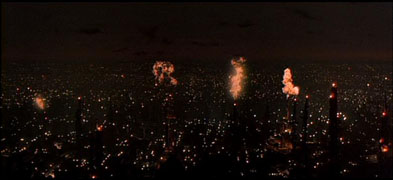 |
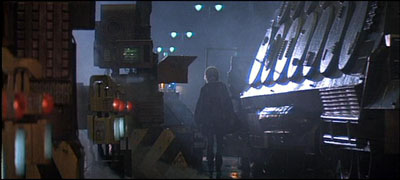 |
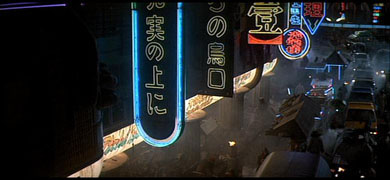 |
||
Tavis
McAuley Similar to Metropolis 2001 the presence of natural materials and animals
is limited to the opulent residence of the Tyrell Corporation Headquarters.
Natural stone appears to be the finish and the |
|||||
| 2. |
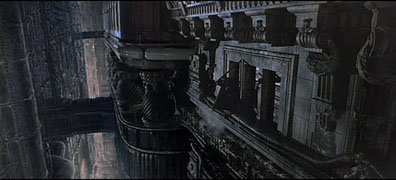 |
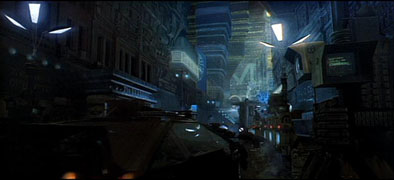 |
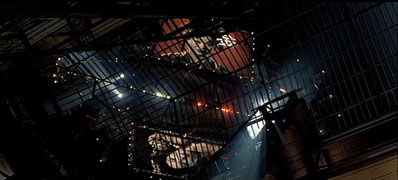 |
||
Jonah
Humphrey Throughout the design of the futuristic environment of Blade Runner, we can see a common idea of l ayering applied to the various techniques used to produce the film. Syd Mead was hired by director Ridely Scott as a primary designer for the film, initially coming up with the designs for the flying police cars, or ‘spinners’. Though this area of design work developed primarily from a background in industrial design, it is quite telling that even here, Mead’s design process informed some of the methods for developing the entire environment of the megalopolis in which Blade Runner is set. Mead firstly would always consider the context in which he would design any object, giving surroundings and scenarios in which these futuristic vehicles, people and environments could co-exist. Further, as with the spinner design itself, he would first come up with a pure form for the object, and successively add layers of equipment, piping, and elements of technology to give more realism and texture to the design. A similar idea of accumulating complexity through layers is found in the design of the buildings themselves, as exemplified in Mead’s own description of the city: The idea was that basically it was going to be unpleasant to be at street level in the cities. The old city structures would still be there, but the buildings might now be hollowed out and used as service access or plenum chambers for the really big megastructures above them. (Shay, 200, 8) These techniques of conceptual layering, then apply directly to the development of scale models in the film, as shown in the application of rubber molds and styrene strips applied to the 9 by 9 foot foam core model of Tyrell’s pyramid, and the various layers of conduit and piping found throughout the modeled buildings making up the cityscape of this dark future. It was the layering of shots in the film, however, that ultimately gives the work such a convincing vision of a grim, but active future. By combining matte paintings of the cityscape with shots of existing buildings, such as with the exterior views of the Bradbury building, or the interiors of Frank Lloyd Wright’s Ennis-Brown House (which was also reconstituted into a skyscraper through exterior sets and renderings), the vision of the future is made tangible, by its very reference to the present and the past. It is then, through the fundamental principle of layering, both spatially and temporally, that such a frightening vision of the future can seem so close, as perhaps it mimics the very layering and growth we find in real cities today. Shay, Don. Blade Runner: The Inside Story . Titan Books: London , 2000.
|
|||||
| 3. | 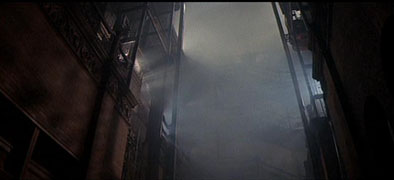 |
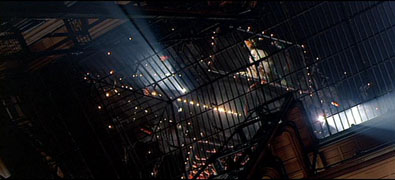 |
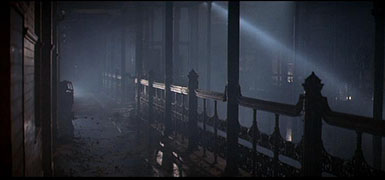 |
||
Michael
Taylor When looking at the movie blade runner and the retrofit of the Bradbury building, it is important to note why the architecture appears so dystopic in the film. The original building itself constructed in the late 19th century was designated as space for an office, with hydraulic lifts and ornate wrought iron interior decoration. The movie with its addition of special effects: Ridley Scott's use of fog, low lighting, and what seems to be garbage strewn on the site gives a sense of how to view the degradation of humanity into the robotic age. While a purely computer graphically integrated artifical space would have cause for a more prototypical futuristic dystopia, it is the fact that we recognize the building itself as a piece of human history, or that it be pointed out to us (in my case) as a structure created ealier which has through the peril of time, machination, and robotics (as in the nature of blade runner) has become a symbol for the overarching entropy of the present. It is through this recognition that we are able to formulate our own perceptions of what exists in the future. Just as if this space was to be light and harmonious, with the absence of dank, dark places, we would believe it to be a utopia. It is the transformation of the space that makes it so efficient in its task of displaying to us the banal nature of human culture. The lonely architect of artifical humanity shouldn't be living in the high rise or elitist buildings, but here as an ecclectic individual inhabiting his world with his own creations, no matter how primitive they have become. Even in the blimp scene as viewed from the interior atrium of the bradbury
building, Scott gives us the concious impression that the space could
potentially exist in the future. The integration of real world architecture
into a fictional setting allows even further draw of the viewer to believe
the film to be a reality. This is effective in that bringing the connection
of the movie to the individual creates emotional and physical links to
the characters inhabiting the space. While some critics may say that
the building has become fully unrecognisable, perhaps it is not only
the building that is important but that the architecture is known and
accepted as authentic. Or perhaps even more true, the fact that the building
has been so disjointed, modified, and recreated is effectually a better
method of describing how the present reflects those same ideas because
the building is unrecognizable. |
|||||
| x | 4. | 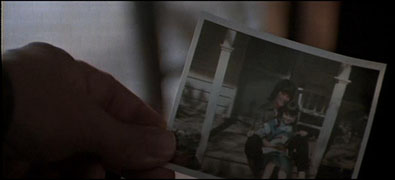 |
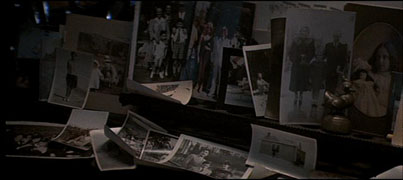 |
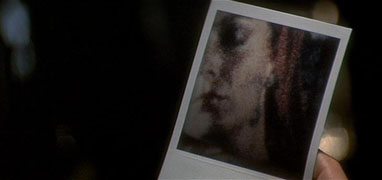 |
x |
Arjun
Mani In Ridley Scott’s future, cities have continued their unyielding growth, and civilization has transcended the confines of our shrinking planet. Moreover the individual’s identity has vanished into the cacophony, and along with it, his ability to question and perceive it. With science having infiltrated the sacred workings of life itself, we can no longer rely on our abilities to discern between what we know and what actually is. Ridley Scott stresses upon this frightful scenario by turning a familiar suggestion on its head--pictures that once could speak a thousand words, are now discredited, only serving to provide a false comfort with false truths in the face of constant paranoia. Deckard, an ace Blade Runner, has honed his ability to distinguish between the real and artificially constructed facets of human nature. After he so crudely dismisses Rachael as a replicant, her memories as that of another, we become aware of how shaky and unreliable our most personal truths and understandings have become. The picture that once captured her eventful and shaping childhood now amounts to nothing more than a lie, however, she is still a product of and connected to those lies. Interestingly, the shrine of photos Deckard has scattered on his piano seems to expose his own frailties and paranoia, almost there to comfort him with proof of past and identity. Curiously enough, it is a picture that sets off Deckard’s investigation. With mind-boggling technology it seems that pictures can sometimes speak much more than a thousand words in Ridley Scott’s future. Deckard extracts from the photo a ‘hidden truth’ which leads him to Zhora. This, however, does not work against the theme of shaky truths, but rather compliments it with the notion of intuitive truths. Pictures have long served as cues to our memories and our past, and are subsequently inherently linked to our perceptions of life. Rachael is still shaped by her false memories, and they are a part of her life regardless of their artificial origins. The movie asks the audience to question and revaluate what it is to be human as well as the validity of perception. Ultimately, Rachael and more importantly Deckard’s quick acceptance of the truth (ie. that he is a replicant) persuades the audience to consider that perceptions of life are distinctly individual and relative experiences. Regardless of artificial intervention, we are shaped by what we perceive.
|
|||||
| 5. | 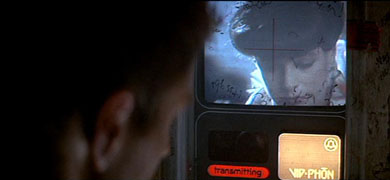 |
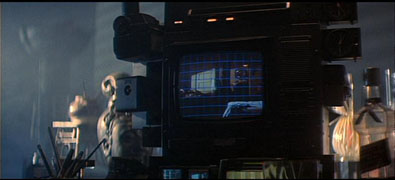 |
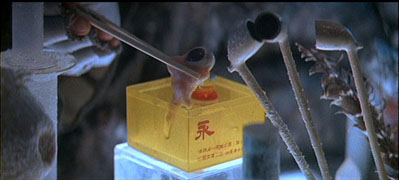 |
||
Aleks
Kolbas The state of technology in both 2019 and 1927 is presented in similar manner; however the controlled use of special effects and wide range of cinematographic use of digital camera makes the environment created in 2019 much more believable, and thus more successful as a presentation of dystopia. What actually makes the cinema more believable in recent times is the use of so called ‘green screens’, or more widely used ‘blue or chroma key screens’, to manipulate or ‘superimpose’ background digitally in the editing room after the live scenes have been shot in front of them. These alteration techniques give the filmmaker a freedom to make the background images more real, with digital quality. Compared to technology used in 1927 version of Metropolis, where background images were painted on canvases or built in miniature sets to alter scale and present a futuristic result, often proved ineffective for the audience to feel convinced of their authenticity. Because of this cinematic phenomenon, the effects of technologies in ‘Blade Runner’ versus ‘Metropolis 1927’, both attempting to show future in their own relative times, the 2019 future shows more maturity in presenting dystopia, simply for the fact that the background images such as triangular building (Tyrrel Corporation), the flying cars with awesome spaceship-like sound were unusual and futuristic in nature. The triangular structure was reminiscent to ancient pyramids of Gods, which suggests that power of the supernatural or Godlike figure is still present, even in the future. This parallel between space age and distant history was interesting, showing the reincarnation of ancient power overshadowed in one of the main characters of the movie, the maker of Nexus6 generation, who lived at the top levels of the ‘pyramid’. Detective Deckard was living in a high-rise far above the ground at which the commoners lived. The non-human or replicants often did not have a place to live at all. This constant play between the architecture of the environment and the characters which inhabit it made the set more in tune with the story, presenting a clear denomination of hierarchical levels. The building themselves were sleek, made of bronze steel, and always shot in the dark and rainy night sets, which made them feel omnipotent and overpowering over the people which inhabit them. This effect adds to the intimidation factor in the viewers of the film, further improving the quality of the dystopic nature. This answer can be seen as biased because of both movies’ time differences. To be more precise, if I saw ‘Metropolis 1927’ seventy years ago, its empowering effect of the future might be equal if not greater than that of Blade Runner’s. But this can only be left for speculation.
|
|||||
| 6. | 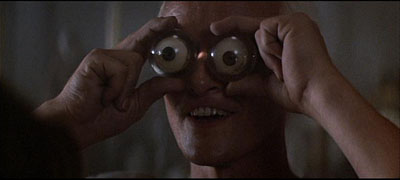 |
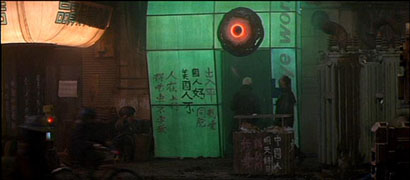 |
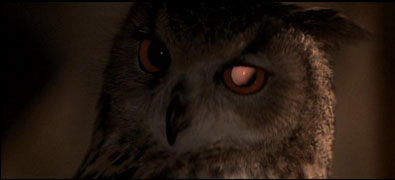 |
||
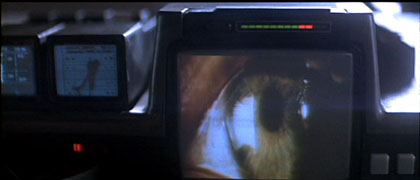 |
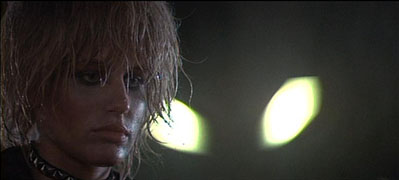 |
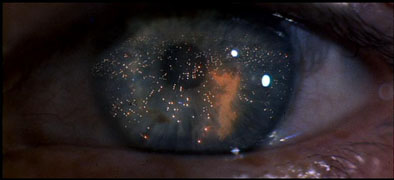 |
|||
Ben
Nielson Eye imagery is used in Blade Runner to illuminate the fine line the film draws between what is human, and what is not – and examining the film’s use of eye imagery reveals an avant-garde/surrealist flavour to Scott’s art that reminds us to take the film seriously. The film establishes the eye as an indicator of humanity in a literal sense shortly after it opens, showing the ‘VK’ test being used to detect Replicants by measuring emotional responses to questions based on involuntary iris-dilation. The eye is said to be the ‘window to the soul’, and in Scott’s futuristic LA it’s the only sure way to differentiate between humans and Replicants. Having established the eye as a symbolic indicator of humanity, Scott uses eye imagery in a variety of ways to comment on the characters in his film. Replicant eyes often reflect back solid orange light, giving an extremely shallow and artificial appearance and helping to identify the false from the real: Deckard’s ambiguous identity is called to attention with a brief frame where his eyes too catch the light to appear flat and orange. The unsympathetic creator, Tyrell, wears thick glasses over his eyes as a mediating layer of logical science; filtering the world for him. If eyes delineate Man from Replicant, then when Roy has crushed his creator’s eyes he is left the more human of the two. Looked at from an artistic, avant-garde film perspective, the scene’s distinctive brutality is an indicator that the scene is important to the film’s message: wake up; I want you to remember this scene, right here. The film is largely concerned with identifying what makes one ‘human’ and seeing the play between Roy’s emotional response to Tyrell’s decidedly un-sympathetic reaction, and the destruction of the only biological indicator of Tyrell’s humanity establishes that question as the theme to be explored as the plot develops. The use of brutality, of shock value, to indicate scenes of special symbolic importance without significantly affecting the plot emphasizes a surrealist reading of the film. The scene was axed in a series of censor cuts for the US theatrical release and Directors Cut in an effort to appeal to audiences, to lower ratings and make the film easier to follow. Examining the symbolic role of eye-imagery in Blade Runner identifies the film’s preoccupation with the definition of humanity, and also identifies a surrealist flavour to the films use of symbolism that reminds us that it takes its artistic role seriously – even as it excels in a medium of popular entertainment. |
|||||
| 7. | 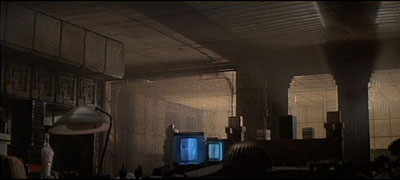 |
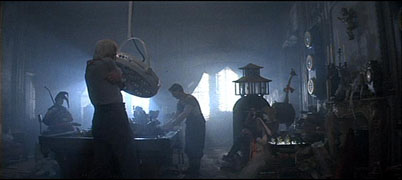 |
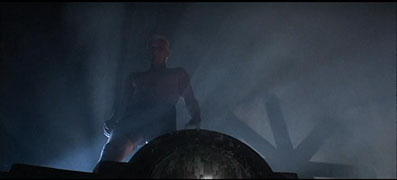 |
||
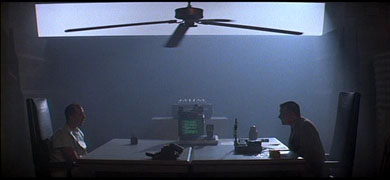 |
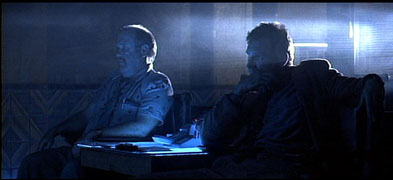 |
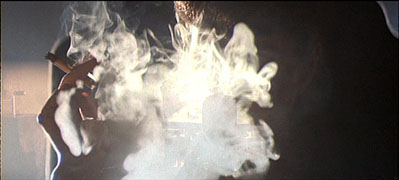 |
|||
Ivy
Ho Lighting in Blade Runner sets the tone for the dark future city of Los Angeles , reinforcing an atmosphere of grime and the sense of anonymity. Most scenes are dimly lit. The action occurs away from the light, which enter rooms indirectly from unknown sources. Thus, the characters seem to be always hidden in the dark. Details of their faces or clothing are obscured by this type of lighting; thus, they become anonymous in their dark city. To further this sense of hiding, are the bright beams of search lights that enter into rooms and buildings. They are always moving and monitoring the city. The most memorable scene that illustrates this effect is when Deckard enters the Bradbury Building to look for Sebastian’s Apartment. The atrium is almost completely in the dark, except when two bright and penetrating beams of lights shine over parts of the building, creating the sense that, perhaps, this city is being monitored by a higher authority. The city itself also seems to always be shielded behind a screen of smog, rain or smoke. The indirect lights are diffused through these atmospheric screens, creating murky views of the urban streets. Blade Runner extended the techniques of low-key lighting utilized in earlier films, such as Metropolis, to include more movement and texture to the lights. Texture is added by filtering or diffusing light through a screen of smoke, rain or fog. Movement is added to the key light, thereby, transforming it from a studio element into an integral part of the city that’s being filmed. Thus, the old techniques of film noir lighting are taken further by the addition of dynamism and texture.
|
|||||
8. |
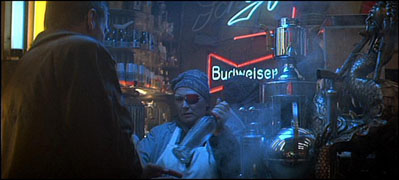 |
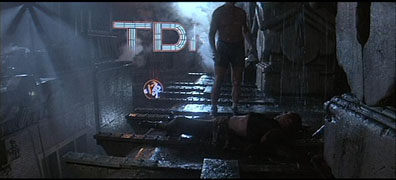 |
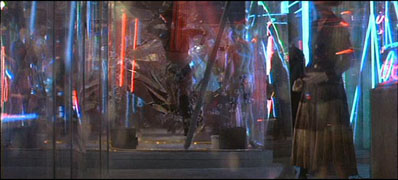 |
||
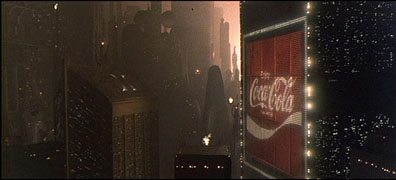 |
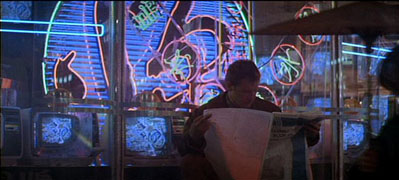 |
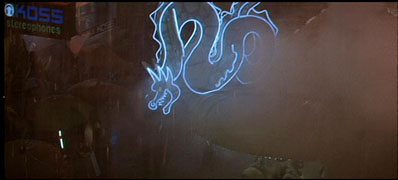 |
|||
Nu-Ri
Lee The use of neon/signage portrays a rather believable environment of the story plot to play out. The streets of the city are heavily crowded with inhabitants and it seems frequent with downpour of heavy rain onto the waste-filled streets and the ever bright and huge illuminated signage adds to the sense of disorientation and chaos portrayed. This dirty, smoke filled city seems like a terrible place and offers a bleak view of the future world, which is far removed from our sense of normality. Consequently this futuristic environment with nothing but artificialness of the neon lights and signage makes the idea plausible of having Nexus-6 generation of robots that are more human than human, yet still artificial beings to exist and were once marketed. The world of LA 2019 appears to be an unappealing place where in the Director’s cut, it seems that the artificial neon lights have replaced natural sunlight. At times it is confusing because we find ourselves feeling as though the interior shots had natural light shining through windows or blinds, but when the frame zooms outside of the building, it was either the artificial light of cars or a huge floating signage by that room/building. The neon lights that light up huge advertisements constantly bombard this life with excessive capitalism. Every which way are ads either as giant floats or on billboards of buildings, in fact it seems as though they are the only source of real light in the city. Actually the people on the streets are quite colorless compared to the neon lights on the streets where even their umbrellas are more animated than the people of the city. Ironically, the lights that gives an artificial and darkness to the city is in fact the source that lights up the streets as well. This futuristic environment seem more like a prison where everything is dark except for the spot lights that lights up the hallway, the jail cells and the individual lights that the guards carry. It almost feels like that the floating neon signage in a way becomes a monitoring moving search light of the city. The life and environment created by the neon lights and signage may seem artificial and chaotic, but they give what little animation it has of the city.
|
|||||
| 9. | 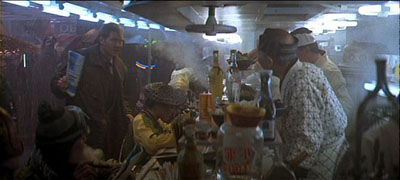 |
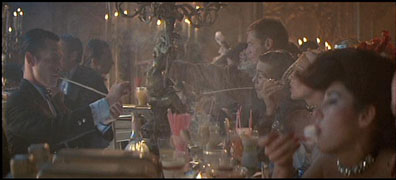 |
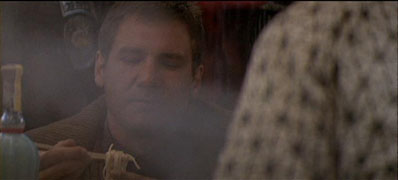 |
||
Vera
Guo There has been a major shift from the theatrical stage settings towards a more realistic location from the past movies we have viewed to Blade Runner. In Blade Runner, it is more of a feeling of an event happening before use as opposed to a storytelling with accompanying backdrops. As technology advances, the subtle details in the props allow audiences to pick up information without thinking too deeply in symbolism. Although the act of eating is strongly symbolic, it is specifically what and where an individual is eating that reveal the nature in which a movie takes place. At the beginning of Blade Runner, Deckard starts a meal at an oriental style fast food noodle kiosk. It portrays a future that is current to the trend of rising populations of Asians this is not a far-fetched portrayal. The fast food street vendor also reveals the poor social conditions of the times and the state in which the planet is in contrast to the advertisement of a better life floating above. Deckard is then arrested while eating and he continues to eat in the police vehicle, showing that he is either more powerful then the cop or that he does not care, informing audiences of his disdain towards the law and calm personality towards a potentially dangerous situation. It gives him an attitude typical of most leading male characters of sci-fi movies; also, it seems in the future citizens of such unruly metropolises are desensitized too many situations. This meal scene is strategically placed at the beginning right after an explanation about robots that are identical to humans. Because Deckard is seen eating, subconsciously, we assume he is human. It seems to be his last and only meal but we do not see any of the other robots having a meal. By the end of the movie you might wonder if he was naturally hungry or programmed to be so. Since I have watched the movie AI I assume robots can not eat and therefore I believe that the major significance to this scene is to prove that Deckard is human. I believe there is also a fascination in science fiction movies to depict how we will go about our everyday essentials such as eating, driving, etc. It is always exciting for audience members to see different creative takes on the director’s imagination whether or not it advances us in the plot, although it does create a stronger setting and culture. It is one of the reasons I personally watch sci-fi.
|
|||||
| 10. |  |
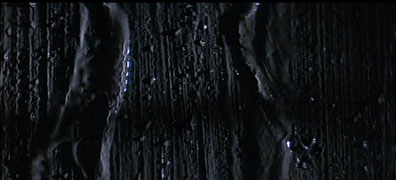 |
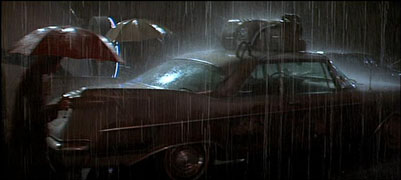 |
||
Michael
Lin The use of rain/water mixed with darkness adds two additional filters on to the lens of the camera to generate the atmosphere in Blade Runner. Previous films rely on certain acting styles, makeup, architecture, sets to create the overall sense of doom and fear. And although the Black Cat takes place partly in a rainy night, the use of rain/water mixed with darkness is prevalent in Blade Runner. The persistent rain and darkness is likely due to the pollution and overdevelopment of the kind of high-tech, industrialized, and decaying earth of Blade Runner. These elements bring out the emphasis of a dystopian cityscape that has very little hope for the future (not unlike Zone-1 of Osamu Tezuka’s Metropolis). A downward spiral of societal collapse in the city is reflected in the cycle of pollution and rain coming back down to earth furthering the process of decay. Most of the city life is shot in this rain and darkness throughout the movie. The only source of light is seen in scenes that show the Tyrell Corporation as this large shiny Tower-of-Babel-like structure where the creator of the Replicants live, perhaps indicating the source of the city’s condition. The interview with Syd Mead reveals the dark and dystopic intention behind the set designs. Syd’s holistic approach to creating a future cityscape involves the design of all elements from fashion to vehicle to architecture. It is no surprise that the environmental effects of rain and darkness help tie in the dystopian character. The persistent theme of rain and decay dominate the film’s atmosphere. As we approach the end of the movie, we find a moment of light in this heavy darkness when the Replicant Roy saves the life of Deckard before his life expires on a rooftop near the Bradbury Building . The rain in this scene, just as morning breaks, can be seen as the one single moment in the film where instead of an element of decay, it is a source of cleansing and redemption. The life of Deckard saved by Roy consequently leads to the sparing of Rachael’s life as they escape together. Roy ’s own life is much less fortunate and as he fades into the darkness, like the city itself is slowly fading, the despair and utter hopelessness in his words, “All those moments will be lost in time. Like tears in rain. Time to die.” resound loud and clear with the futureless earth, one plagued with rain and darkness.
|
|||||
| 11. | 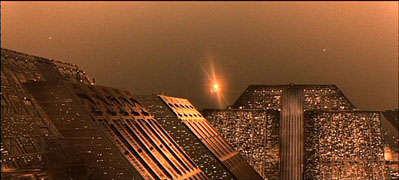 |
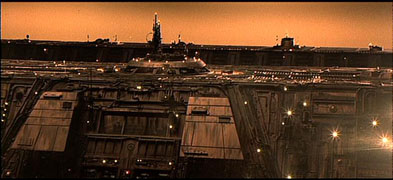 |
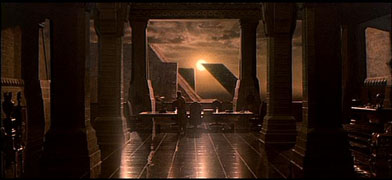 |
||
Collin
Gardner The functionality of the buildings proposed by futurist Syd Mead is
important in the context of blade runner. The images Mead produces
are meant to depict a dark and dystopic future for the purposes of
eliciting an emotional response from an audience. |
|||||
| 12. | 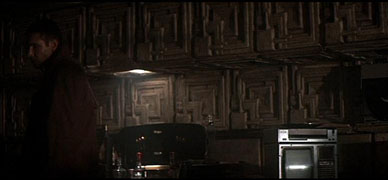 |
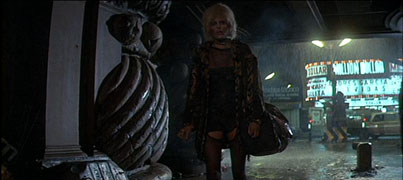 |
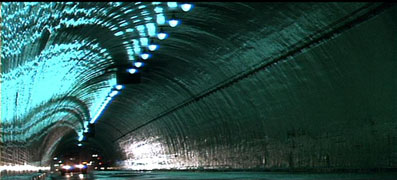 |
||
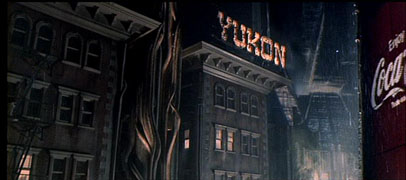 |
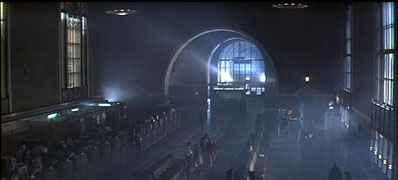 |
 |
|||
Joel
DiGiacomo The use of recognizable buildings in the set of a movie is arguably essential to its believability, as a city's buildings, especially landmark buildings tend to be preserved throughout its history, even if their use changes. Blade Runner understands this fact in its depiction of present-day L.A. Buildings. The Bradbury building, currently an office building, and the oldest building in central L.A., has an extended entrance canopy, and is mostly abandoned, save for its sole resident J.F. Sebastian. L.A.'s Union Station has been converted to police headquarters, while other old buildings have been retrofitted to function as service access to newer, much taller adjacent structures. The film is set 37 years into the future, so it is very conceivable that the buildings shown are still existing. Furthermore, the opportunity to contrast familiar settings –as many Los Angeles landmarks have been featured in Hollywood films– with their possible future, dystopian state strengthens the audience's understanding of the movie's theme.
|
|||||
| 13. | 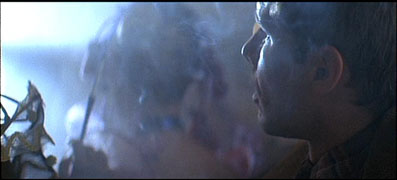 |
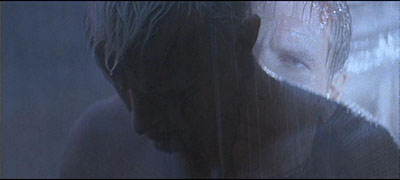 |
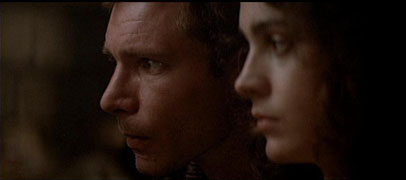 |
||
Suzanne
Gibson Blade Runner is a movie that relies primary on imagery to advance the plot, images unfold to tell a story of depth and complexity, although the plot remains unclear and ambiguous. Images are given with no explanation, and it is left for the viewer to fill in the blanks, unfortunately in the international cut voice over down play the important of the imagery in the original movie. For this response I will use the directors cut as the primary focus, in this case the director has a greater responsibility to the viewer in presenting the images in a meaningful manner. One instance of presentation can be seen in the changing of focus, and depth of field, compliment by juxtaposition that advance the plot. The first instance of the can be seen in the opening scene, the first image presented to the viewer is an industrial hell, that is Los Angeles 2019. Then the viewer is presented with an eye within which the landscape is reflected, serving to remind the viewer of the individual within the sea of built typography. This form of presentation relies on the framing of images to heighten the visual impact, and hence captures the height of action and rendering each frame from the best possible angle, this is performed by changing the focus and depth of field. In many ways this approach emulates the layout of comic panels. According
to Scott McCloud, and his article “Understanding Comic”,
a comic view is “Juxtaposed pictorial and other images in deliberate
sequence, intended to convey information and / or to produce an aesthetic
response in the view”. In this case the foreground and background
objects are commonly in sharp focus with equal clarity, and like a
comic strip the action takes place within a framed view, commonly these
views are framed by the changing focus and a layering of depth, and
can be seen in the lack of moving shot. The camera tends to remain
motionless and it is the characters that move in and out of the framed
view. Often scenes are shot from the direct line of action, this also
allowing the camera to remain static. This approach, is appropriate
in creating subtle shifts in the attention of the viewer, as each frame
has carefully a defined relationship with the viewer and surrounding,
creating a window through which the viewers attention is focused. The
position of the camera remains the same and it is the camera focus
and depth of perception that changes and directs the viewers attention
to a different aspect of the shot, and therefore creating an increased
sense of detail and intensity of the imagery in the film. |
|||||
| 14. | 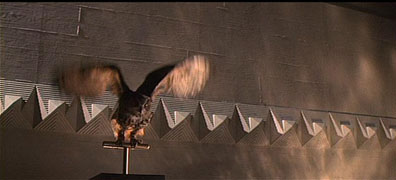 |
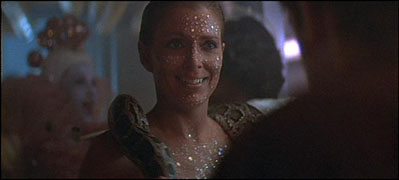 |
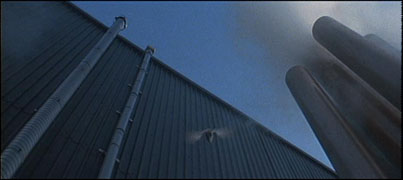 |
||
Darcy
McNinch I must admit I have never read the novel upon which Blade Runner is based, ‘Do Androids Dream of Electric Sheep’, but the title and what I’ve heard of it reinforce the importance of animals in the story. It appears in this future that most animals have come close or already are extinct. People who own live animals need to be wealthy and are respected for their support of other life forms. People who can’t afford to own live animals may turn to robotic ones to give off the appearance of power and wealth. There are hints that animal species are being forgotten, for instance when the android being questioned at the beginning of the film doesn’t know what a tortoise is. I find the thought that humanity has destroyed most other forms of life in the future to be a very frightening possibility. A world that would not be able to support animal life due to pollution and overdevelopment is very dystopic. There are a lot of bird images in the film, birds being a symbol of peace and freedom, something which the characters seem to need but lack. The fact that the birds may be robotic adds a weird spin to their symbolism. These ersatz birds are a last attempt from humanity to create the world they have already destroyed. The film shows how fragile life is and how easily it can be lost or taken. The androids lives are not their own, they are slaves who are destroyed when they are no longer useful. The extent to which everything is controlled or owned, including life is also shown in the scene when Harrison Ford’s character is searching for the manufacturer of the snake scale he finds. The thought that there are copyrights and manufacturers of quasi-living creatures is reminiscent of what is happening currently with stem-cell research, genome projects, and the copyrighting of DNA strands. The movies plot is also greatly linked with the animals, and I believe in the book it is even more so. The false snake scales are what lead him to the one android, and the Sean Young characters android owl help give her away. The scientist seems to have an affinity for the birds and the other detective leaves his trademark, origami animals everywhere he goes. The film creates a dystopic feeling with its notion that humanity has almost destroyed the animal kingdom and that we have begun creating robotocized ones to replace the real ones. This idea and the also the symbolism related to certain animals is central to the film.
|
|||||
| 15. | 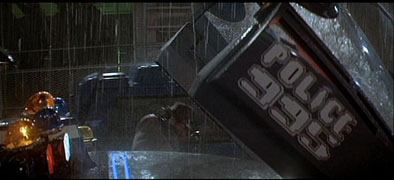 |
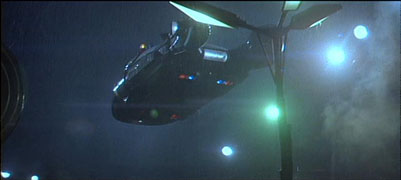 |
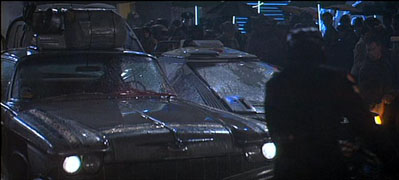 |
||
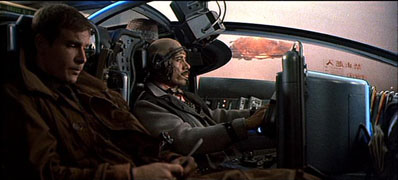 |
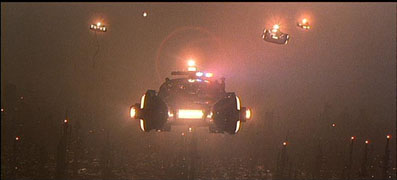 |
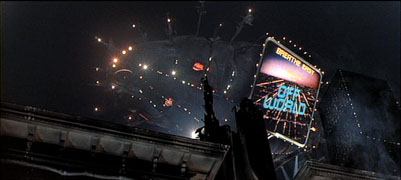 |
|||
Uros
Novakovic Blade Runner presents a dystopic vision of technologically advanced future, where new modes of transportation assume the cultural place of the current. Unlike Metropolis 1927 and 2001, which merely magnify and perfect the already existing technology, Blade Runner assumes invention of new futuristic vehicles and giant space ships. In Blade Runner the change is qualitative while in Metropolis it is quantitative. In Metropolis 1927, the major mode of transport is the automobile, augmented with planes, trains and zeppelins, all of which were already present (in lesser quantities) at the time of the film production. Similarly, Metropolis 2001 generally utilizes already available transportation technology of conventional cars, futuristic but seemingly feasible high-speed trains, conveyor belts used as moving sidewalks and flying craft of various sizes (some of which are less feasible than others). Interestingly, in neither of these films do the transportation mechanism interact prominently with the major characters and plot development. They are mostly used as a background (moving images) onto which the action is projected fairly independently. Particularly, in Metropolis 1927, although massive infrastructure seems to have been built to accommodate the spread of automobile, there is no sense the new ‘automobile elevated highway experience’ from a human point of view. With the exception of the massive elevators carrying workers to their underworld city, the characters do not meaningfully interact with the futuristic transportation infrastructure. In Blade Runner a qualitative difference in transportation mechanisms is achieved with the introduction of hovercraft and giant spaceships, able to support a massive off-world colonization. Both of these new transportation technologies, are also fundamental to the plot and character development. The police is defined as possessing hovercraft (an ideal of liberation from traffic congestion), and it is once Deckard is taken off in one that he becomes a Blade Runner. The possibility of off-world colonies also defines the second-rate underclass character of most of the remaining earthlings, an example of which is the J.F. Sebastian who remains on earth solely since he can not pass the health test for the off-world colonies. Intrinsically, the new modes of transportation in Blade Runner take on the roles that a car already performed in North America in the second half of twentieth century: they provide a greater sense of freedom to a priviledged class giving it power to both dominate the urban environment (hovercraft) and escape it if necessary (off-world spaceship).
|
|||||
| 16. |  |
 |
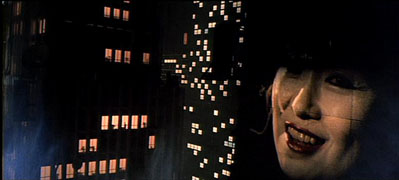 |
x | |
John
Lee At first, the potential of an off-world colony in Blade Runner seems to provides hope for those wishing to escape the squalor of future Los Angeles. However, it becomes apparent that this hope is a mere mirage, perpetuated by corporate culture, a culture of greed and a disparate power structure. The off-world colonies and prevalent corporate culture promote a disposability of human life that is dishearteningly dehumanizing, evidenced by their use of replicants as slaves. Furthermore, the off-world colonies are used as devices to further divide classes, by sending the elite to new frontiers and leaving lower classes in contaminated LA. Essentially the very essence of humanity is questioned, not just for the replicants but for the forsaken citizens as well. In Blade Runner, then, the off-world colonies represent a vicious cycle within which modern society is trapped, and it is the unattainability of an off-world paradise and a lack of humanity emphasizes the hopelessness of Blade Runner’s dystopia, and thereby paints a bleaker picture than either Metropolis. In Metropolis 1927, though the workers' humanity is put into question, they are decidedly human, a quality emphasized by their panicked realization about their children. The ending, also, has a sense of optimism that borders on naivete, whereas Blade Runner conveys hopelessness.
|
|||||
| 17. | 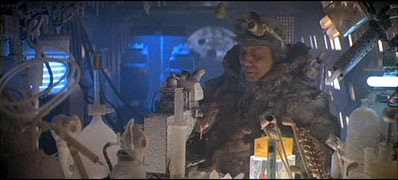 |
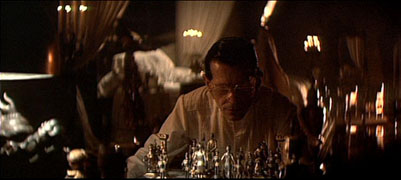 |
 |
||
Holly
Young In each of the films we have viewed to date, the character of the ‘mad scientist’ is used to support and develop an environment of fear. In fact, it is often the work of the scientist/inventor that provides the inciting force in the plot from which the dystopic atmosphere, the basis for these movies, is created. In The Cabinet of Dr. Caligari, the doctor brings his somnambulist into the previously peaceful town, and orchestrates a killing-spree, terrorizing the community. The inventors in both Metropolis films are caught up in creating the most advanced, and most human-like, robots of their time; and though each society was fragmented long before their inception, the development of these machines was ultimately what brought their earlier conflicts to destructive climax. The Black Cat introduces a pair of happy honeymooners to an evil architect who attempts to entrap the couple so that he may use them in a satanic ritual in his basement, where he keeps previous beautiful, female sacrifices in a sort of suspended animation. Every one of these films utilizes the role of the scientist as a catalyst to bring to the plot the same element of dystopia already present in the set design. Then, both work together to create the overall environment of fear in which their stories can be told. In Blade Runner, the role of the mad scientist is taken on by the employees and owner of the Tyrell Corporation, whose figure head is Eldon Tyrell. These employees are in charge of designing and manufacturing robots who are indistinguishable from human beings and who are developed to colonize planets for the use of those rich enough to leave the wasteland that earth has become. Unlike Caligari or Black Cat, but in the same vein as the Metropolis films, Blade Runner is dystopic before the introduction of the scientists and their work into the film. First, we are shown devastating class stratification resulting in atrocious living conditions for the lower classes on earth, where the story is set, while the rich move on to the advertised utopias being built on other planets. However, when we meet Eldon Tyrell and are introduced to the replicants he created, the environment of fear intensifies: the scientist both strengthens and aggravates the existing social circumstances with his invention. We not only see the role that the robots play in enabling this severe class structure, but the lives that they have been forced to live, and the atrocities they are capable of. Their characters bring the fear-inspiring social conditions that had formed the background setting for the film into its action, into its plot; and without the scientist or inventor, these characters would not exist. Tyrell is seen as the ‘evil genius’ behind it all, using his intelligence to exact an amount of control over the society in which he lives. But why is a ‘mad scientist’ such a popular character to use in order to create or strengthen an environment of fear in a dystopic film? In our society, we believe that there is a fine line between genius and insanity. Knowledge is power, and power corrupts. In the movies we have been shown so far, the scientists and inventors have been so caught up in what they can accomplish, that they don’t stop to think about whether it should be accomplished. They are working in scientific territory that is unprecedented, where morals haven’t had a chance to develop yet; therefore these inventors may consider themselves ‘above morals’: a terrifying thought. In fact, even scientists with the best intentions, when accomplishing things never dreamed of before, may create without fully understanding what repercussions their work may have. The super-intelligent human being disturbs the viewer much more than a fictional monster could, because we can better relate. It is much more unnerving to know that there are human beings out there, much like ourselves, that are capable of such atrocity.
|
|||||
| 18. | 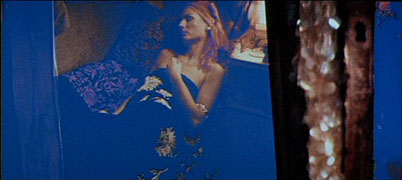 |
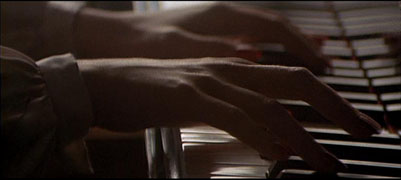 |
 |
||
Jody
Patterson The Surrealist and Dadaist movements promoted themselves as anti-art, a rejection of artistic standards in order to provoke their audience in unexpected ways. This was evident in Un Chien Andalou as well as in the series of Dadaist short films, which operate as a stream of consciousness independent of the constraints of plot or even plausibility. Both movements aimed to create an art form expressive of their time, in deliberate counterpoint to any artistic conventions. Surrealism and Dadaism sought freedom from the rules of traditional art in order to experiment with what a truly contemporary form of expression might be like. Bladerunner presents a world of the future where, despite the highly advanced technology evident in all aspects of public life, the realm of private life is portayed as very conventional even to today’s standards. Art is practiced, it seems, only within that private domestic realm. Contrary to the tenets of Surrealism or Dadaism, in the hypermodern time of 2019 art is not experimental or futuristic, but deeply traditional. The master of robotic science plays not virtual reality video games, but chess on a marble board. Deckard’s sheet music is a classical melody, which Rachael plays on an ivory-keyed piano – not an experimental modern piece on an electric instrument. Sebastian makes old-fashioned wooden toys by hand, for his enjoyment alone, although they are wholly obsolete in a world of robots so advanced as to replicate humans. The irony is that, while these conventional artistic expressions could be interpreted as a solace from technology, it is the replicants who prove themselves the masters of each art. Art in 2019 could operate as a return to otherwise forgotten origins for human artists, but for the replicants it seems a far more spiritual endeavor – to practice according to a tradition which is not their own, to participate in a history they cannot have. Artistic expression in Bladerunner is thus a somewhat melancholy practice, which is communicated by the quiet and the old-fashioned settings of the candlelit bedroom, the piano covered with faded photos, and the sawdusty menagerie of toys in the workshop, respectively. Thus while Surrealist and Dadaist art films strove for contemporary expression by denying conventions, art in 2019 returns to old rules and conventions: a subtle and private denunciation of the contemporary world. The practice of art in 2019 is not to express their time but to escape their time, even reject it, if only within the privacy of the home. |
|||||
| 19. | 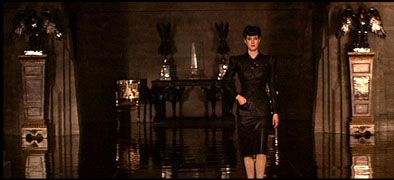 |
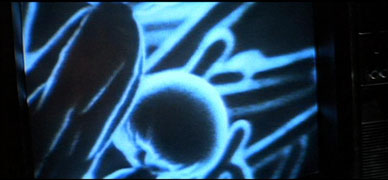 |
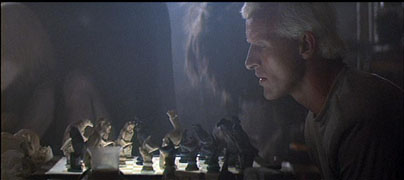 |
||
Michael
Morgan In the film Bladerunner, we see Dr. Tyrell as a character that tries to achieve perfection solely through technological means. To be clear, in this context we will define ‘achieving perfection’ as not just creating something that is flawless and/or without defect, but in this process becoming god-like. Furthermore, the technological means referred to in the initial proposition are the making of things through the use of scientific innovation and manufacturing processes. We can see how this idea is illustrated in the film through the use of characters and architectural setting. The Tyrell Corporation and its founder Dr. Tyrell specialize in designing and manufacturing robots. Each new version that is produced is more human then the last with the aim of achieving the ultimate goal of creating a robot that is identical to a human. In essence, they are trying to achieve god’s work (create human life) through technological means as opposed to natural ones. This is evident in the film through the characters Roy and Rachael. Roy is a Nexus 6 replicant, a robot designed to have greater then human strength and academic intelligence. The draw back with Roy is that he is designed only to have a life span of four years limiting his time to collect experiences and memories, and in turn, stifle his emotional development. Rachael, (Roy’s successor) is a robot designed with no expiry date and is equipped to deal with emotions on the same level as humans. The progression from Roy to Rachael depicts Dr. Tyrell’s ambitions to achieve God’s work through the use of technology. Dr. Tyrell’s divine ambitions are further personified through the appearance of his corporation’s main building. In this case direct comparisons can be made to Egyptian pyramids where a pure geometric form that stands apart and above its surroundings has been created in order to signify one’s direct connection with some sort divine figure/world. To be specific, this technological temple is meant to symbolize Dr. Tyrell and his creation of robots that are identical to humans as an almost heavenly act. Upon closer examination we see how this pure geometric form is comprised of a series of steel skeletons, pipes and circuitry giving the building its industrial appearance and simultaneously reaffirming Dr. Tyrell supposed ascension to godliness through technological means. Taken together it becomes clear how Rachael, Roy, and the Tyrell Corporations main building exemplify the divine aspirations of Dr. Tyrell.
|
|||||
| 20. | 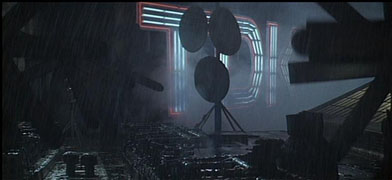 |
 |
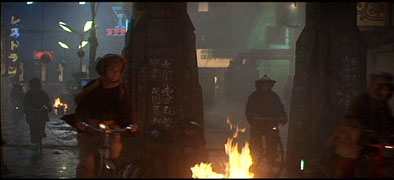 |
||
Ashley
Snell I think that the use of decay in buildings, as it relates to the plot, is very effective. The decay is a repercussion of technologies. Although the film is not about building technology, it is paralleled by the advanced technology of human genetics and recreating them. Why look after the old buildings falling into decay when newer, bigger buildings can be built? And same goes for people in the film, let them live in the slums. The use of decay in buildings was to represent the low lives of society. The decaying buildings are closer to the earth, in the shadows of the towering skyscrapers. The skyscrapers are owned and occupied by big corporations with money. The film shows two extremes of life and living conditions. The idea of the big wigs overshadowing, literally and figuratively, and representing the image of power over the lower classes supports a dystopic political environment. The replicants hide out in the decay because they are rejected from higher forms of human life. It is easier for them to hide out in the decay with the other low lives. Sebastian used to work for Tyrell in the genetics department. He has a disorder and therefore no longer works for Tyrell and lives in the slums below. Other genetic artists live in the decay as well. All of the deaths of the replicants happen down in the decaying buildings too. The film portrays an image that all bad and ill-breed people live in the decaying areas, unworthy of a nice place to live. The upper classes have no clue what is happening in the streets below because they dare not step foot down there. Tyrell and the head of the Blade Runners are never shown in the streets. The clear stratification of classes supports the dystopic social environment.
|
|||||
| 21. | 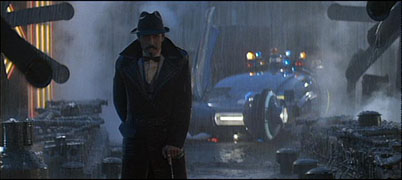 |
 |
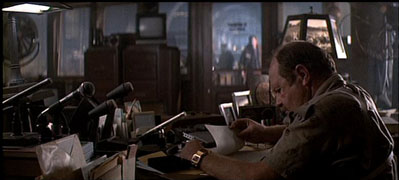 |
||
Veronica
Lorenzo Luaces-Pico I have been having trouble to answer this question. It seems to me that in Blade Runner the viewer relates more easily to the police figure. The main character is the one whose job it is to do the right thing, and that is to kill any replicants - even though they don't refer to this as murder. Society is divided up into humans and not-humans, and it is someone's job to judge where the fine line is. In Metropolis, we are being controlled by the police. In a way, we feel like replicants, running away from the oppression and the controlling monopoly that the police is, just trying to survive. We relate more to the working class, to the 'simplest' of all types of beings. We are being judged, and we feel that even when we do our best and we over-work, they will still want more than we can give from us. We are always being tested, all eyes controlling our every move. In Caligari the notion of what is human and what is not is being questioned by insanity. We relate to him all through the movie and then realize that he is insane. It parallels the way a replicant must feel realizing he or she is not human. In terms
of architecture in the movie Blade Runner, police figures and the environment
around them feel isolated from the rest of the film. The different
characters playing the police feel very human, they look like people
we would know and are able to relate to. At the same time, they are living
in a metropolis where nearly all plants and animals, except for human
beings, have died. The interior design relates more to traditional police
stations, and so do their clothes; a reflection of their old-fashioned
ideas. They play two opposing ideas creating a tense sense of dystopia
throughout the film. |
|||||